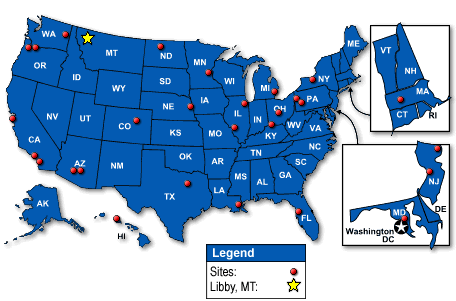|
|
ATSDR conducted the National Asbestos Exposure Review (NAER) project to evaluate sites that received and processed vermiculite mined in Libby, Montana. ATSDR is working on this project with local, state, and other federal agencies. Libby vermiculite was shipped more than 200 locations around the U.S. for processing. We now know that this vermiculite contained asbestos.
ATSDR will produce a health consultation, a fact sheet, and media announcement for each site listed below. All materials will be posted here as they become available. Please check the individual sites below to see the information currently available.
National Asbestos Exposure Review Sites
Note: To view site location or additional information, roll over and click on the dot or star on the image map below. Alternatively, use the Sites by Region table for additional information.

What is Vermiculite? Is All Vermiculite Hazardous?
Vermiculite ore is a naturally occurring mineral used widely in various consumer products, such as attic insulation, lawn and garden products, and fireproofing material.
Most vermiculite ore and products do not pose a health hazard. Vermiculite from Libby, Montana is of special concern because it contains asbestos.
Prolonged exposure to asbestos can cause very serious health problems, including asbestosis, mesothelioma, and lung cancer.
People who believe they have been exposed should consult a health care professional with expertise in asbestos related disease. Consult a doctor in your area or search the links available on the NAER links page.
Asbestos and Libby Vermiculite
Vermiculite was mined and processed in Libby, Montana, from the early 1920s through 1990.
The Libby mine is now closed, but many studies show that people who worked in the Libby mine or vermiculite processing facilities—and those who lived near these sites—were exposed to hazardous levels of asbestos while the facilities were in operation.
Site-Specific Information
The National Asbestos Exposure Review (NAER) will focus on 28 sites that received approximately 80 percent of the vermiculite mined in Libby from 1964 through 1980. ATSDR and other agencies are evaluating human health effects that may be associated with past or current exposure to asbestos at the processing sites and in adjacent communities.
ATSDR will make these evaluations and agency recommendations, in the form of fact sheets and other documents, available to the public as studies are completed.
Downloadable Map PDF This map shows the locations of the sites and outlines ATSDR's organizational regions, which correspond with EPA's regions. Below, these sites are listed alphabetically by city.
ATSDR will investigate sites that processed Libby vermiculite in two ways:
- By identifying ways that people could have been exposed to asbestos in the past or ways that people could be exposed now; and
- By determining whether the exposures represent a public health hazard.
ATSDR will use the information from these site investigations to determine appropriate actions, as needed, to protect public health in each location.
ATSDR selected these 28 sites because they fell into at least one of two categories:
- The U.S. Environmental Protection Agency (EPA) mandated further action at the site on the basis of current contamination; OR
- The site was an exfoliation facility that processed roughly 100,000 tons or more of vermiculite from the Libby mine. Exfoliation is a process in which vermiculite ore is heated at high temperatures to expand or "pop" it. These facilities are of particular concern because exfoliation causes higher amounts of asbestos to be released than other processing methods.
Fact sheets reporting the results for each site evaluation will be made public through the media and on this site as they are completed. A summary report will consolidate findings and recommendations involving all 28 sites.
This page last updated on August 06, 2008
